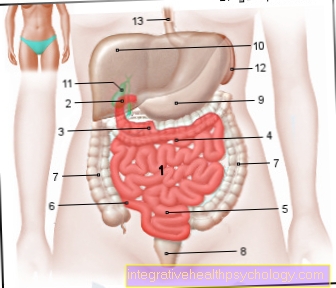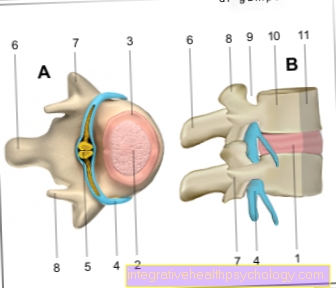Macrolides
introduction
Macrolides are antibiotics that are primarily effective against intracellular bacteria, i.e. bacteria that infiltrate various body cells. For example, macrolides can be used against various pathogens against which penicillins and cephalosporins, for example, are not effective. The effect of the macrolides is based on the fact that they inhibit the reproduction of bacteria (bacteriostatic) and thus stop the spread of the bacterial infection.
Read more on the subject at: Antibiotics

Indications for macrolides
Indications for therapy with macrolides are (as with all other antibiotics) infections with bacterial pathogens. As a class of antibiotics, macrolides are particularly effective against bacteria that “hide” in the body's own cells. Macrolides can be used particularly well against bacteria from the group of chlamydia or mycoplasma. Chlamydia are bacteria that mainly cause infections of the genital organs. Mycoplasmas, on the other hand, tend to settle in the airways.
Read more on the subject at: Chlamydial infection
Macrolides also work against so-called gram-negative bacteria. These are bacteria that use a special staining method (Grief staining) do not stain. They include types of bacteria such as Legionella (these typically cause pneumonia) and Neisseria (typical pathogens for sexually transmitted diseases and meningitis). But also gram-positive bacteria (which can be stained with the Gram stain) such as streptococci can be treated with macrolides. Streptococci can cause tonsillitis in the context of scarlet fever or soft tissue inflammation, otitis media and meningitis.
The macrolides are thus a group of antibiotics that are effective against a large number of bacterial infections. Overall, macrolides are suitable against almost all respiratory diseases. They are also used against many sexually transmitted diseases and bacterial skin diseases. It is important to note that enterobacteria (which are mainly found in the digestive tract) cannot be treated with macrolides. Therefore, macrolides are not suitable for treating urinary tract infections and bladder infections.
Active ingredient and effect
The effect of macrolides is based on an inhibition in the formation of various proteins of the bacteria. So-called ribosomes are required for the formation of these bacterial proteins. These are large structures on which the genetic material of the bacteria is translated. The macrolides attach themselves to the ribosomes and thus prevent other substances that are required for the translation of this genetic material from docking on the ribosomes.
This stops the formation of proteins in the bacteria. The bacteria cannot reproduce their genetic material and cell growth comes to a standstill. In addition, no new bacteria can develop. This mechanism enables bacterial infections to be treated with macrolide therapy. The active ingredients that are used are erythromycin, azithromycin, clarithromycin and rocithromycin.
Side effects
The main side effects of the macrolides are the effects on the liver. Treatment with macrolides can damage the liver cells. The higher the dose of the active ingredient, the more likely this damage will occur. This is mainly due to the fact that the macrolides are metabolized in the liver and are also excreted via the liver. This causes the macrolides to accumulate in the liver. Excessive active levels can become toxic for the liver cells and damage them.
Other side effects mainly affect the heart. There the so-called QT time is prolonged, which can lead to disturbances in the heart rhythm. In particular, people with pre-existing heart diseases should therefore only be treated with macrolides carefully or not at all.
Other side effects of the macrolides are due to their action against bacteria. Treatment with macrolides not only prevents the bacteria that cause infection from growing. The natural skin and intestinal flora, which also consists of bacteria, is also influenced by the macrolides. Therapy can therefore lead to side effects in the digestive tract such as nausea, vomiting, diarrhea and also abdominal pain and cramps. The side effects on the skin often only become noticeable when the immune system is weakened. If the protective skin germs have been killed by the macrolides, other pathogens such as fungi can settle on the skin and lead to fungal infections there.
Read more on the subject at: Side effects of antibiotics
interaction
Interactions between macrolides and other drugs can mainly be traced back to its effect on a certain enzyme in the liver metabolism. This is the enzyme CYP3A4, which plays a major role in the processing of many substances.
The effect of the CYP3A4 is inhibited and slowed down by the macrolides. This influences the metabolism of drugs such as statins (fat lowerers), steroids, the birth control pill, cortisone, immunosuppressants (drugs that downregulate the immune system), psychotropic drugs (drugs that are used for psychological illnesses) and many other substances . Some drugs are broken down faster than usual, others stay in the body for a particularly long time. Interactions with grapefruit juice can also be triggered via CYP3A4.
Contraindications - When should macrolides not be given?
Macrolides are especially not allowed to be given if there is an allergy to the active ingredient. The macrolides must not be given even if there are intolerances to other substances contained in the medication. There are other contraindications, for example, for liver diseases. Since the macrolides are metabolized in the liver and can cause damage there in turn, macrolides must not be taken in severe liver diseases. If necessary, macrolides can be administered in a significantly lower dose for liver damage, but it is better to switch to other groups of antibiotics.
dosage
The dosage of macrolides depends on the group of macrolides, the underlying infectious disease and, if applicable, the body weight of the person being treated. The severity of the disease can also play a role in the dosage; there are also different dosages for administration in the form of a tablet and administration via the vein (intravenous) used.
Erythromycin is prescribed in a maximum dose of 4g per day. The standard dose via the vein is 1 g twice (= 1000 mg); in tablet form, 500 mg is usually taken three times a day. Azithromycin, on the other hand, is only taken once a day, usually 500 mg each. Clarythomycin can be taken twice a day, the dosage can be between 250 and 500 mg per tablet. The dosage must be adjusted, especially if the liver is damaged. If the liver is damaged too much, macrolides must not be used.
price
The price for macrolides cannot be determined across the board. It depends mainly on the form of administration (tablets or solution for administration via the vein). The dosage and the pack size also play a role, as does the exact group of macrolides contained in the preparation. Macrolides require a prescription and can therefore only be purchased in pharmacies with a prescription. As a rule, only the prescription fee of € 5 is due, the remaining costs are covered by health insurance.
In the case of intravenous treatment of macrolides (administration of the antibiotic into the vein), the drug usually does not have to be bought in the pharmacy. Instead, the treatment takes place, for example, as part of a hospital stay. In this case, the health insurance covers the full cost of antibiotic therapy with macrolides.
Macrolides and alcohol - are they compatible?
Macrolides - like most antibiotics - are mainly metabolized in the liver and then excreted via the liver. This can lead to interactions with simultaneous consumption of alcohol and therapy with macrolides. So macrolides and alcohol do not go well together.
Alcohol also has to be metabolized in the liver. Therefore the substances can influence each other. For example, the active levels of the macrolides can increase, as the alcohol in the body slows down the breakdown of the active ingredient. Above all, this increases the side effects of the macrolides and can even lead to poisoning symptoms due to excessively high active levels in the body. In addition, the breakdown of macrolides and alcohol can be slowed down, which is why high blood alcohol levels can be reached even with little alcohol consumption.
Alternatives
Alternatives to macrolides are usually offered by other antibiotics. For example, many bacterial diseases can be treated with penicillins, cephalosporins or fluoroquinolones. However, the effectiveness of the different classes of antibiotics varies for the different groups of bacteria.
Macrolides are mainly used when antibiotics with fewer side effects such as penicillins and cephalosporins are no longer effective. As an alternative to macrolides, other highly effective antibiotics, such as fluoroquinolones or carbapenems, are often available.
Can it be taken during pregnancy and breastfeeding?
There are not enough data available for the administration of the various macrolides during pregnancy and breastfeeding to make a specific statement about the intake. It has not been finally clarified whether the active ingredients can be transferred to the child via the placenta (placenta) during pregnancy. It is also not known whether the macrolides can be passed on to the child through breast milk. In addition, it has not been clarified whether the active ingredients, if they reach the unborn or breastfed child, will also damage it. For this reason, macrolides should only be taken during pregnancy and breastfeeding after carefully weighing the benefits and risks.
Read more on the subject at: Antibiotics in Pregnancy and Antibiotics while breastfeeding
Effectiveness of the pill with macrolides
If macrolides and the pill are taken at the same time, the effectiveness of the pill may deteriorate. However, an exact statement about the effectiveness of the pill cannot be made in connection with macrolides, since not all macrolides have been tested with all active ingredients of the various pills. However, some studies found that the pill was less effective when used with macrolides. Therefore, one should assume that the effectiveness of the pill is reduced when taking macrolides at the same time. Therefore, an additional method of contraception should be used for the period of antibiotic intake.





























